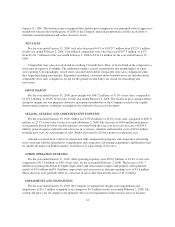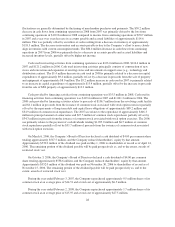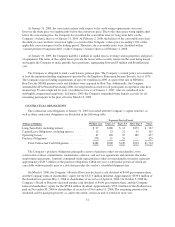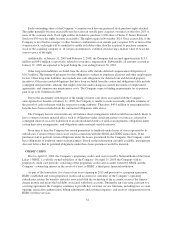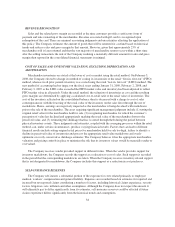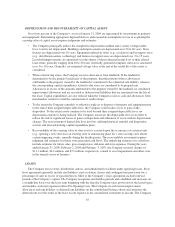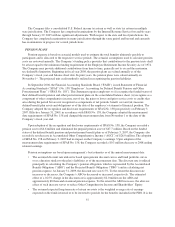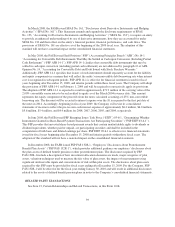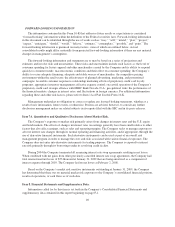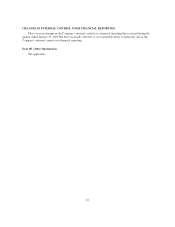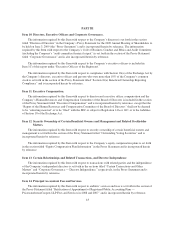Saks Fifth Avenue 2008 Annual Report Download - page 34
Download and view the complete annual report
Please find page 34 of the 2008 Saks Fifth Avenue annual report below. You can navigate through the pages in the report by either clicking on the pages listed below, or by using the keyword search tool below to find specific information within the annual report.At the end of the ten-year term expiring in 2013, the agreement can be renewed for two two-year terms. At
the end of the agreement, the Company has the right to repurchase, at fair value, all of the accounts and
outstanding accounts receivable, negotiate a new agreement with HSBC or begin issuing private label credit
cards itself or through others. The agreement allows the Company to terminate the agreement early following the
occurrence of certain events, the most significant of which would be HSBC’s failure to pay owed amounts,
bankruptcy, a change in control or a material adverse change in HSBC’s ability to perform under the agreement.
The agreement also allows for HSBC to terminate the agreement if the Company fails to pay owed amounts or
enters bankruptcy. Should either the Company or HSBC choose to terminate the agreement early, the Company
has the right, but not the requirement, to repurchase the credit card accounts and associated accounts receivable
from HSBC at their fair value. The Company is contingently liable to pay monies to HSBC in the event of an
early termination or a significant disposition of stores. The contingent payment is based upon a declining portion
of an amount established at the beginning of the ten-year agreement and on a prorated portion of significant store
closings. The maximum contingent payment had the agreement been terminated early at January 31, 2009 would
have been approximately $21.8 million. Management believes the risk of incurring a contingent payment is
remote.
In September of 2006 the Company entered into agreements with HSBC and MasterCard International
Incorporated to issue a co-branded MasterCard card to new and existing proprietary credit card customers. Under
this program, qualifying customers are issued a SFA and MasterCard-branded credit card that functions as a
traditional proprietary credit card when used at any SFA or OFF 5th store and at Saks Direct or as a MasterCard
card when used at any unaffiliated location that accepts MasterCard cards. HSBC establishes and owns the
co-brand accounts, retains the benefits and sales associated with the ownership of the accounts, receives the
finance charge and other income from the accounts, and incurs the bad-debts associated with the accounts.
CAPITAL NEEDS
The Company estimates capital expenditures for 2009 will be approximately $60 million, net of any
proceeds, primarily for store expansions and renovations, enhancements to management information systems,
maintenance capital and replacement capital expenditures.
The Company anticipates that working capital requirements related to existing stores, store expansions,
store renovations and capital expenditures will be funded through cash on hand, cash provided by operations and
the revolving credit facility. Maximum availability under the revolving credit facility is $500 million and there is
no debt rating trigger. During periods in which availability under the facility exceeds $60 million, the Company
is not subject to financial covenants. If availability under the facility were to decrease to less than $60 million,
the Company would be subject to a minimum fixed charge coverage ratio of 1 to 1. During 2008, weighted
average letters of credit issued under this credit facility were $28.6 million and letters of credit reduce the amount
available to borrow. The highest amount of letters of credit outstanding under the facility during 2008 was $34.3
million. The Company expects that its cash flows from operating activities combined with borrowings under its
revolving credit facility will be sufficient to sustain its current level of operations.
CRITICAL ACCOUNTING POLICIES AND ESTIMATES
The Company’s critical accounting policies and estimates are discussed in the notes to the consolidated
financial statements. Certain judgments and estimates utilized in implementing these accounting policies are
likewise discussed in each of the notes to the consolidated financial statements. The following discussion
aggregates the judgments and uncertainties affecting the application of these policies and estimates and the
likelihood that materially different amounts would be reported under varying conditions and assumptions.
33



